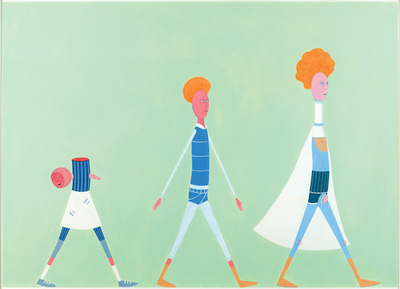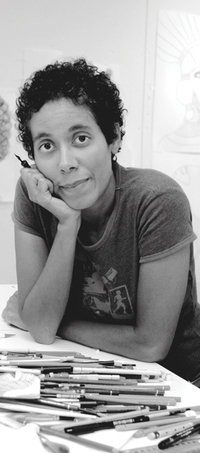Laylah Ali

Laylah Ali, Untitled (Acephalous series), 2015, gouache, acrylic, watercolor, and pencil on paper, 40½ x 56″. Courtesy of Paul Kasmin Gallery.
Laylah Ali is not exactly a portrait painter. Not in the classic sense of a model sitting while an artist paints—like Sargent or Rembrandt or even Frank Auerbach. Ali never uses models; her paintings come from her imagination. She doesn’t even paint people, per se, and never specific people; they’re anthropomorphic “beings”—gender neutral, race obscure, sometimes missing a limb or a head or a whole body. But what remains in her images are exactly what the best portraitists capture—attitudes, gestures, interior worlds.
Ali is an artist and a professor of art at Williams College in Williamstown, MA. Her “Greenheads series” was the subject of a major touring exhibition that originated at the Williams College Museum of Art and traveled to the Weisman Museum, University of Minnesota, Minneapolis, MN and the Herbert F. Johnson Museum, Cornell University, Ithaca, NY. She’s had solo shows at the deCordova Sculpture Park and Museum, Lincoln, MA; the Museum of Modern Art, New York, NY; the Institute of Contemporary Art, Boston, MA and others. Her work is in the permanent collections of numerous museums including the Albright-Knox Art Gallery, Buffalo, NY; the Museum of Contemporary Art, Chicago, IL; the Museum of Modern Art, New York, NY; and the Walker Art Center, Minneapolis, MN.
Her latest works, referred to as the “Acephalous series” are gouache, acrylic, watercolor, and pencil on paper. Acephalous comes from the Greek word for “headless” and in anthropology describes a society without a leader. In Untitled (almost all of her works are untitled), three figures stride like the Beatles on Abbey Road. The one in front wears kneepads, a cape, and has a pouf of orange hair. It could be an armless superhero. Next in line is a character in a blue-striped shirt also with a nimbus of orange hair perched on its egg-shaped head. Pulling up the rear, in a skirt, is a being with a sliced-off head jammed through its trunk. While the body language in all three is purposeful, the headless face is anguished.
Ali considers her paintings to be both objects and ideas. They are not meant to be overt—although it’s easy to make assumptions. Her job is to present the interactions and the viewer gets to interpret. Who has the power in this picture? What does the body language reveal about the situation? These questions draw the viewer
in for a closer look where assumptions get topsy-turvy.

Laylah Ali in her studio. Courtesy of the artist and Paul Kasmin Gallery.
In another Untitled, a beet-looking being is in conversation with a mythological lamia. Very unexpected. The beet’s tiny tongue lifts up at the end and the snake/woman looks stone-faced back at it. Is the beet pleading for its life or is it the one in control? Ali’s paintings are filled with control. There is also sickness, impulse, and holding on to each other’s neediness. When asked to describe her work, she says she’s “putting forward propositions and distillations that have a precedent but are futuristically oriented.”
Ali grew up in “a sloppy house,” but her paintings are anything but sloppy. They’re formalist and precise. She draws the stripes with a ruler, she measures the angle of a coat, and she moves her “characters” up and down on the page to get the perspective exactly right. Even the paint she works over and over.
In her “Greenheads series,” she opted for a saturated palette. The “Acephalous series” is more muted, more delicate. She mixes the color until “Just the edge…like the saturation is about to exhale…you’ve got the color but you’re about to lose it,” she says. She is slow and deliberate with each painting taking a long time to make. Her art doesn’t have to pay her bills, she says, her teaching does, and this gives her the freedom to create without restrictions. There are close to 100 Greenheads and about 30 in addition.
Ali is “fussy and particular.” She draws first and then paints on top. Her drawings are calculated and careful, “the way I tell my students not to draw.” This phase of her process involves measuring and moving images and considering negative space. The size of the stripes needs to be checked, the distance between two beings needs to be double-checked. As she’s gotten older, she says, she’s even more that way and calls it her “practice-induced OCD.” She has a program and a checklist, “boom, boom, boom,” she says. She knows she’s done when, and she sucks in air, “they’re ready to go…they seal off.”

Laylah Ali, Untitled (Acephalous series), 2015, gouache, acrylic, watercolor, and pencil on paper, 14 x 56″. Courtesy of Paul Kasmin Gallery.
Ali grew up a self-described “outsider” in a town near Buffalo, NY. She was a biracial kid in an all-white school, a light-skinned girl in a black family, and a dark-skinned girl in a white family. Her father came from a family of sharecroppers in Mississippi; her mother from a WASPy family of lawyers. It was a meeting of two worlds. “Visually, if you grow up like that, you’re aware just for your own safety, or of your own social idea, of what can happen to you. You learn to sense those feelings…a lot goes unspoken.”
Ali didn’t start out wanting to be an artist. She always thought she’d be a lawyer. She likes “organizational and structural change,” she says. Her dream had been to stand in front of the Supreme Court and argue for revamping the way public schools are funded by property tax. Today, among other issues, she is passionate about museum fees.
As a child, she spent a lot of time at the Albright-Knox Art Gallery—located midway between her divorced parents’ houses. When it was cold out (“cause it was Buffalo…it’s always freezing!”), or when she was bored, she would go look at art. She didn’t have money but the museum was free. “Museums have wildly miscalculated how those fees…what kind of message they send to people.” Instead of building fancy new wings, Ali believes museums should be free.
When asked why she makes art, she replies, “It’s an electrical necessity.” She often has “unresolved stuff” that she wants to put in a more constructive place. Her paintings are a place to ask questions. When she doesn’t make art, the behaviors she doesn’t love spill over. “I’d rather act it out in my paintings,” she says.
Sarah Baker is a contributing editor for Art New England.
